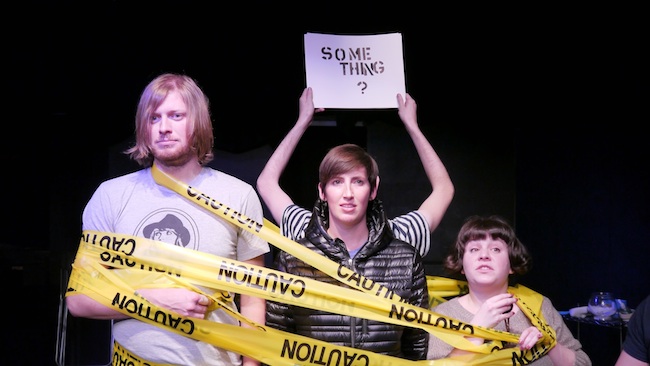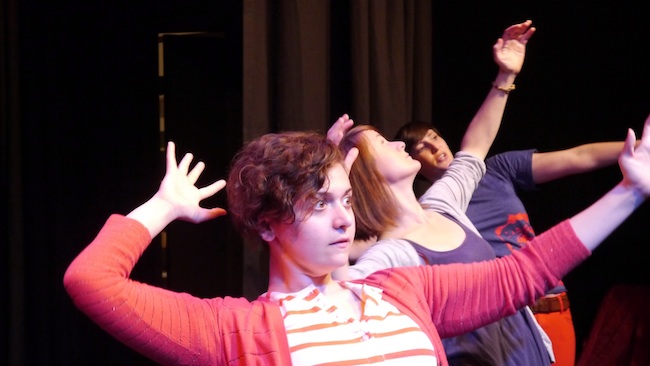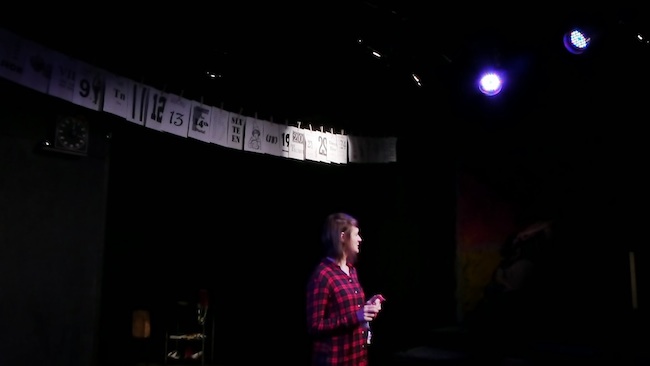
A blue plastic action figure was my ticket into an hour of hot peppers, raw meat, boners, ketchup vomit, feminism, Lil Jon, and candid questioning of the human condition. When I entered the Boxcar Theater to see the Neo-Futurist show Too Much Light Makes the Baby Go Blind in the SF Mission on Saturday night, I was handed an action figure and a name tag that read, “Et al.” I took a seat at a table in the front of the tiny black box and reared up to be taken for a ride.
I had seen Too Much Light Makes the Baby Go Blind performed by the Chicago Neo-Futurists twice, but I didn’t know what to expect at the San Francisco version. Not only do the Chicago and SF troupes do different versions of the show, but each troupe does a fresh version of its own show every weekend. The Neo-Futurists present 30 original plays in 60 minutes, with up to six of the plays totally new that week. Each audience-member is given a menu/program with a numbered list of plays in an order that is guaranteed to change.
Here’s how it works: the cast sets a timer for 60 minutes onstage. The audience shouts the number of the first scene they want to see. From that point, at the end of each 1-2 minute play, the audience yells the number of the next play it wants to see. The order is totally random and unexpected for the audience as for the performers. Unlike a traditional play, held together by a prescribed spine of plot, Too Much Light Makes the Baby Go Blind has no predictable flow. The tensions built into the plot of a traditional play come instead from the fact that time is running out in front of the audience’s eyes. I found myself torn between reveling in each bizarre, touching moment and glancing nervously at the clock. Having a timer onstage imposes tension onto a string of plays that otherwise would run suspense-free.
This kinetic erraticism is one of the several ideals the Neo-Futurists inherit from their cultural grandparents, the Italian Futurists. A group of artistic and social reformers, the Futurists set out to destroy and rebuild all of human culture in the pre- WW1 years. Most of their outlandish theories, explained through several manifestos, withered out of relevancy, but the core ideas of the 1915 Synthetic Theater Manifesto live on through the Neo-Futurists. To spare you the technical details of this treatise: it basically lays out a new theater. This theater should be brief; each play encapsulates the entirety of the human experience. Actors are to tell the truth at every turn without, as Marinetti warned, “pandering to the primitivism of the crowd.” Performers actively engage and prod at the audience at every second, with passive participation forbidden. The audience leaves feeling empowered to strike down the government and burn museums. Each moment of a Futurist play must shock and provoke the crowd.

This production of Too Much Light Makes the Baby Go Blind opens with a short performance piece centered around the theoretical quandary of what Neo-Futurist apprentice Serra Naiman would do if her daughter had a mustache. Not a wispy mustache, she clarifies, but a hefty mustache like Ron Swanson on Parks and Rec. With the help of three silent women slowly removing their make-up and then their clothing, Naiman monologues about feminist empowerment in a way that would feel preachy if she weren’t unapologetically wispy—and wearing a fake mustache herself. Before taking her bow, she throws fake mustaches at the audience.
Processing a rapidfire onslaught of avant-garde mini-plays makes it hard to feel honestly moved by every play. But my favorite play, “Hot Pepper Poetry,” exhibits how invested the performers are in each individual play. Megan (all of the performers use their own names instead of character aliases) walks onto the stage, announces, “this is a habanero pepper,” eats it in one bite, and proceeds to read a poem as she spurts and tears up.
Then, of course, “Schrodinger’s Boner” sticks out. Amy, another Neo-Futurist, sits center stage with a stack of narrative signs. She holds up the signs one by one to explain the premise of the Schrodinger’s Cat experiment, then to pose the query of whether its conclusions couldn’t apply to a penis, too. Tyler and Willie walk onstage with their jeans around their ankles and cardboard boxes over their junk, a la “Dick in a Box.” Then Megan begins to read Harry Potter fan fiction from offstage. We are left only with questions.

“Groove Train” literally spurs the audience into dancing action. I, sitting near the front, am pulled into the soul train parading around the theater. Soon, all 40 audience-members join the groove train. 40 strangers and 6 Neo-Futurists land onstage, and all of a sudden “Turn Down for What” blasts through the speakers. For two minutes, 46 complete strangers jump up and down to Lil Jon while Megan delivers a monologue about capitalism. Frat vibe meets avant-garde. For a moment, the SFNFs achieve that tantalizing Futurist goal of compressing the range of a human experience into a fleeting moment in space. But, just as quickly as it has started, the music stops, that play ends, and we return to our seats to marvel as ensemble member Katharine walks onstage to spit out a mouth full of ketchup onto the stage for the next play.
The line between gimmick and truth blurs quickly in this show, especially with performers so eager to provoke. The energy leaps swiftly and often between camp and art. Katharine, a powerhouse performer, seems to be the only one willing to grapple with serious issues in her pieces. Each play she performs in, with the exception of the ketchup piece, tackles questions of democracy, feminism, or death. In “Aubade,” lit at the center of the stage, the ensemble behind her holding black umbrellas and flashlights, Katharine leads a rousing call to action about civil disobedience in China. In another play, she rants about being victimized as a feminist on the internet. The other Neo-Futurists delightedly stuff socks into their pants and run gimmicks but shy away from straightforward, honest reflection. It almost feels unfair that Katharine is relegated to the “serious corner” while everyone else got to do tricks onstage.
Each play didn’t necessarily shock me, and I didn’t leave the theater and march straight to the library to start burning conservative books. In the social anarchist regard, then, perhaps the SF Neo-Futurists fell short. But Too Much Light Makes the Baby Go Blind engaged me; I recommend that anyone interested in feeling simultaneously empowered and befuddled go see it. The show works on you in a way that a traditional, one-plot play cannot rival. It carries you all over the place, then drops you back in your seat and leaves you wondering what you’re doing there. I didn’t watch a play in the Boxcar Theater. Taking “a dynamic leap in the void of human creation, beyond the range of territory previously explored,” just as Marinetti demands, I joined an intimate, universal performance moment.
***
Photo Credit: Adam Smith
